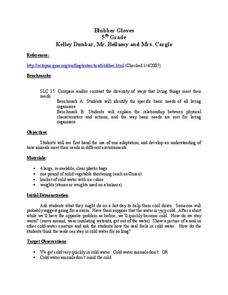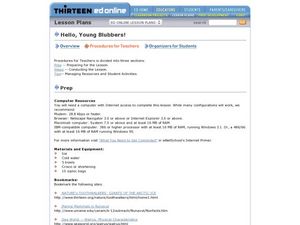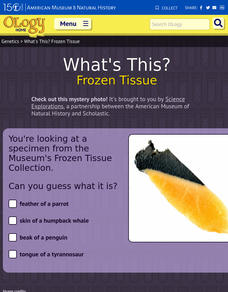American Museum of Natural History
Rubber Blubber Gloves
Using gloves, shortening, tape, and a lot of ice, participants experience the feeling of having blubber. The experiment's eight steps follow an informative page about blubber and animals that have it.
Science Matters
Blubber Gloves: It’s All About Insulation
Instill the concept of adaptation with the help of Blubber Gloves—ziplock bags, shortening, and duct tape. Scholars discuss how animals and plants keep warm in polar regions, record their predictions, and try on their Blubber Gloves to...
Curated OER
Big on Blubber: How do Whales Stay Warm?
Learners explore biology by conducting a science experiment in class. In this whale anatomy lesson, students identify the use of whale blubber for the animal to stay warm in cold waters while utilizing ice, vegetable oil, plastic bags...
Curated OER
Ocean Exploration
Students explore whales. In this animal adaptation and whale activity, students access prior knowledge about whales from previous lessons, then use background knowledge to predict the eating strategies of a baleen whale and a toothed...
Curated OER
Blue Planet: Frozen Seas
Learners study the animals from the Arctic and how they have adapted. For this ocean lesson students create a poster about their given animal and present it to the class.
Texas Instruments
How Do Pinnipeds Stay Warm?
Learners experiment to determine ways different types of insulation materials work. In this animal adaptation lesson, they make hand coverings from plastic bags, shortening, feathers, and wool. They observe effects of these insulating...
Curated OER
Animal Adaptations to the Cold
Student's explore the concept of animal adaptations. In this animal science lesson, students create insulated mittens and conduct an investigation with cold water. Students discuss the results and make connections to animals...
Curated OER
Blubber Gloves
Fifth graders examine animal adaptations and how they meet their needs in a variety of environments. They discuss how they might adapt to their own environment before discussing how an animal could adapt. Next, they complete an...
Curated OER
Hello, Young Blubbers!
Fifth graders explore walrus and their habitat. In this animal adaptation lesson students complete a hands on activity while in groups and use the Internet for research.
Curated OER
In the Company of Whales
Students examine whales and how they migrate. In this whale lesson students research whales and their migration patterns.
Curated OER
Adaptations of Penguins
In this adaptations of penguins worksheet, students write short answers describing 14 ways penguins are adapted for their living environment.
Curated OER
Baleen Whales vs. Toothed Whales
Second graders review mammal characteristics and study two types of whales. In this mammal study lesson, 2nd graders discuss mammals and define their five characteristics. Students complete a whale worksheet and define differences...
Curated OER
Whale Adaptations
Learners explore whales and how they have adapted to survive in the ocean. In this whale adaptations instructional activity students complete several activities that allow them to investigate animal adaptations.
Aquarium of the Pacific
Turn a Cow into a Whale
Third graders explore animals that might have a common ancestor and resemble one another. For this cow and whale lesson plan, 3rd graders recognize the similarities between the whale and the cow. Students complete worksheets...
American Museum of Natural History
What's This? Frozen Tissue
Take a peek into thousands of frozen samples. Learners try to identify an image of a piece of frozen tissue. After choosing the correct answer, scholars find out more information about the American Museum of Natural History's Frozen...
Curated OER
Bears
Students study polar bears and their characteristics. In this bears lesson students divide into groups and design a model that shows the effectiveness of their layers that keep them warm.
Curated OER
Travel to the Polar Lands
Second graders receive an "Expedition Ticket" to travel through the Polar Regions- the Arctic and the Antarctic. They research polar bears and make drawings that are to scale.
Curated OER
Quiz
In this quiz worksheet, students, after researching and discussing different types of world-wide animals, determine the answers to ten key true and false questions.
Science Buddies
Science Buddies: What Are You Blubbering About?
Baby Beluga may swim in the deep blue sea, but the song doesn't mention how cold it is out there. Find out in this short project how a bit of blubber can be a useful adaptation when the water is ice cold.


















